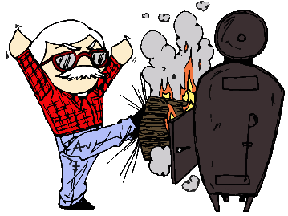Fay Butler Fab/Metal Shaping
Philosophy of a Professional Metal Shaper
|
 |
In this discussion I would like to lay out some ideas that might help a person pursuing a professional metal shaping career in regards to equipment choices and overall shaping philosophy. Creating compound curves in sheet metal is about changing the thickness of the metal. Metals have an elastic limit that needs to be exceeded in order to get the plastic flow to occur to effect this thickness change. Many beginning metal shapers stay with lower yield strength (5,000 to 20,000 pounds per square inch) non-heat treatable aluminum alloys (3003 H14 being most common). This fits the more easily to acquire hand tools and equipment that most first purchase. If they work with steel (45,000 pounds per square inch yield strengths), shaped pieces are often smaller in size, say one foot square, and have less compound curve. |
A wheeling machine, mechanical “jaw” type shrinker/stretcher, hand tools such as standard hammer and dollies, bumping into a sandbag, etc., all depend on a 1/16 horse power human as the energy source. These simple tools are appropriate as people are developing their skills. Also these tools are simple to acquire and move metal slowly—all advantages for novice shapers. A novice will get tired, even with these smaller simpler pieces, before they get too far out of control in the compound curve they are looking to shape. As ones’ skills progress, a good craftsman should outgrow these methods. To also gain the ability to move into larger panels and higher strength materials with more dent resistance in the part, more power becomes beneficial and necessary. This is where a metal shaper needs to move into power equipment. The first piece of powered professional equipment in my opinion is a “Pullmax” style machine. I recommend to people to add this machine first to their shop. A “Pullmax” is a great trimmer, while very versatile in installing details such as offset, joggles, beads and the simple act of turning edges. Alone, this is reason enough to own one of these styles of machines. Adding a set of thumbnail shrink dies in this machine moves one from making parts primarily by stretching to shrinking — useful in the higher crown compound curve shapes. Shrinking using thumbnail dies occurs through what I term “compressive forces,” which is much different from the type of forces used in the mechanical “jaw” type shrinker. Although “jaw” type shrinker machines are necessary, their use needs to be limited to turned flanges when the thumbnail style shrink tooling will not work. I cannot go into why this is the case here, only to say that not all shrinking or stretching is doing the same thing to the metal at the atomic level in terms of the rate of strain or work hardening that occurs, the predictability and stability of the shape, and the ability to work higher strength materials that tend to be “strain sensitive.” Consider a “Pullmax” machine for your shop. (We have written a book on the subject to help those interested in how I use it.) Remember, Pullmax is only one of many manufacturers of this style of machine. The next powered shaping tool would be an air planishing hammer. Appropriately tooled and set up, this is a valuable machine for light shaping and smoothing/planishing of close to finished parts. We also have a book on this tool, with suggestions on how to make your own using an inexpensive pistol grip air chisel. These two powered machines, coupled with the normal hand tools, would be a good compliment. This would allow for larger panel work with more speed, and the ability to move into high strength materials like the 5XXX series aluminum alloys or the heat treatable alloys used in aircraft structures and skins. Common carbon steels with their higher strengths also become easier to shape. Stainless steel can also be shaped to a limited amount, although this material requires a much higher skill. From here the next step, in my opinion, is a traditional power hammer. Power hammers develop the most power when properly set up and operated, that cannot be surpassed in speed and quality of part, along with the most versatility in material choices. Yoder and Pettingell were American companies that made these tools back when the automobile and aircraft industries were being developed in the US just prior to WWII. There are people now reproducing these machines with various qualities. This would compliment the above-mentioned Pullmax style machine and air-planishing hammer, along with the other hand tools in your shop. The wheeling machine at this point would become obsolete, and you would find that your hand tools should be used less. For me, the ultimate part that I look to make needs 4 parameters: 1) limited and even stress in the part, 2) true surfaces 3) with no material removed whatsoever, and last 4) no hand tools needed to be use (i.e. all operations done using the power of the equipment). If any of this seems interesting and/or logical to where you think you might like to move into, then my seminar would lay out a set of principles that would aid you in determining what route you would like to take in pursuing your goals in this trade, from novice to professional. If you have a question you'd like to ask Fay, this is the place to do it. Just click here to send an email. If you want to share your question and Fay's answer with the world on this page, please indicate that along with your question. Otherwise, we will respect your privacy and respond privately. |
|
©2005-2009 Fay Butler